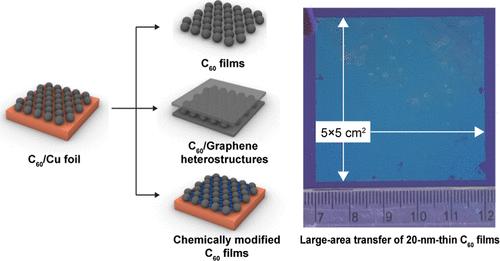纳米C60薄膜的大面积转移
IF 16
1区 材料科学
Q1 CHEMISTRY, MULTIDISCIPLINARY
引用次数: 0
摘要
富勒烯具有明确的分子结构和高可扩展性,有望成为制造各种碳材料的基本基石。在所需表面上精确控制厚度和形态的大面积薄膜的制造和转移对于设计和开发富勒烯基材料和器件至关重要。在这项工作中,我们提出了在各种衬底上固态转移C60分子纳米薄膜的策略,这些薄膜的横向尺寸为厘米,厚度控制在1-20纳米范围内。此外,我们还成功地通过C60和石墨烯薄膜的逐层堆叠制备了厘米宽的石墨烯/C60/石墨烯异质结构。这种转移方法是通用的,允许化学改性C60薄膜的完全转移,包括氧化C60薄膜和C60Pdn有机金属聚合物薄膜。此外,将C60和C60Pdn薄膜直接固态转移到电极表面,可以直接探测其析氢反应的电催化性能。这种薄膜转移策略允许在各种衬底上精确操作大面积超薄C60薄膜,为富勒烯化学和人工碳结构的实验合成提供了平台。本文章由计算机程序翻译,如有差异,请以英文原文为准。

Large-Area Transfer of Nanometer-Thin C60 Films
Fullerenes, with well-defined molecular structures and high scalability, hold promise as fundamental building blocks for creating a variety of carbon materials. The fabrication and transfer of large-area films with precisely controlled thicknesses and morphologies on desired surfaces are crucial for designing and developing fullerene-based materials and devices. In this work, we present strategies for solid-state transferring C60 molecular nanometer-thin films, with dimensions of centimeters in lateral size and thicknesses controlled in the range of 1–20 nm, onto various substrates. Furthermore, we have successfully fabricated centimeter-wide graphene/C60/graphene heterostructures through layer-by-layer stacking of C60 and graphene films. This transfer methodology is versatile, allowing for the complete transfer of chemically modified C60 films, including oxygenated C60 films and C60Pdn organometallic polymer films. Additionally, direct solid-state transfer of C60 and C60Pdn films onto electrode surfaces has enabled their electrocatalytic performance for the hydrogen evolution reaction to be probed directly. This thin-film transfer strategy allows precise manipulation of large-area, ultrathin C60 films on various substrates, providing a platform for fullerene chemistry and the experimental synthesis of artificial carbon structures.
求助全文
通过发布文献求助,成功后即可免费获取论文全文。
去求助
来源期刊

ACS Nano
工程技术-材料科学:综合
CiteScore
26.00
自引率
4.10%
发文量
1627
审稿时长
1.7 months
期刊介绍:
ACS Nano, published monthly, serves as an international forum for comprehensive articles on nanoscience and nanotechnology research at the intersections of chemistry, biology, materials science, physics, and engineering. The journal fosters communication among scientists in these communities, facilitating collaboration, new research opportunities, and advancements through discoveries. ACS Nano covers synthesis, assembly, characterization, theory, and simulation of nanostructures, nanobiotechnology, nanofabrication, methods and tools for nanoscience and nanotechnology, and self- and directed-assembly. Alongside original research articles, it offers thorough reviews, perspectives on cutting-edge research, and discussions envisioning the future of nanoscience and nanotechnology.
 求助内容:
求助内容: 应助结果提醒方式:
应助结果提醒方式:


